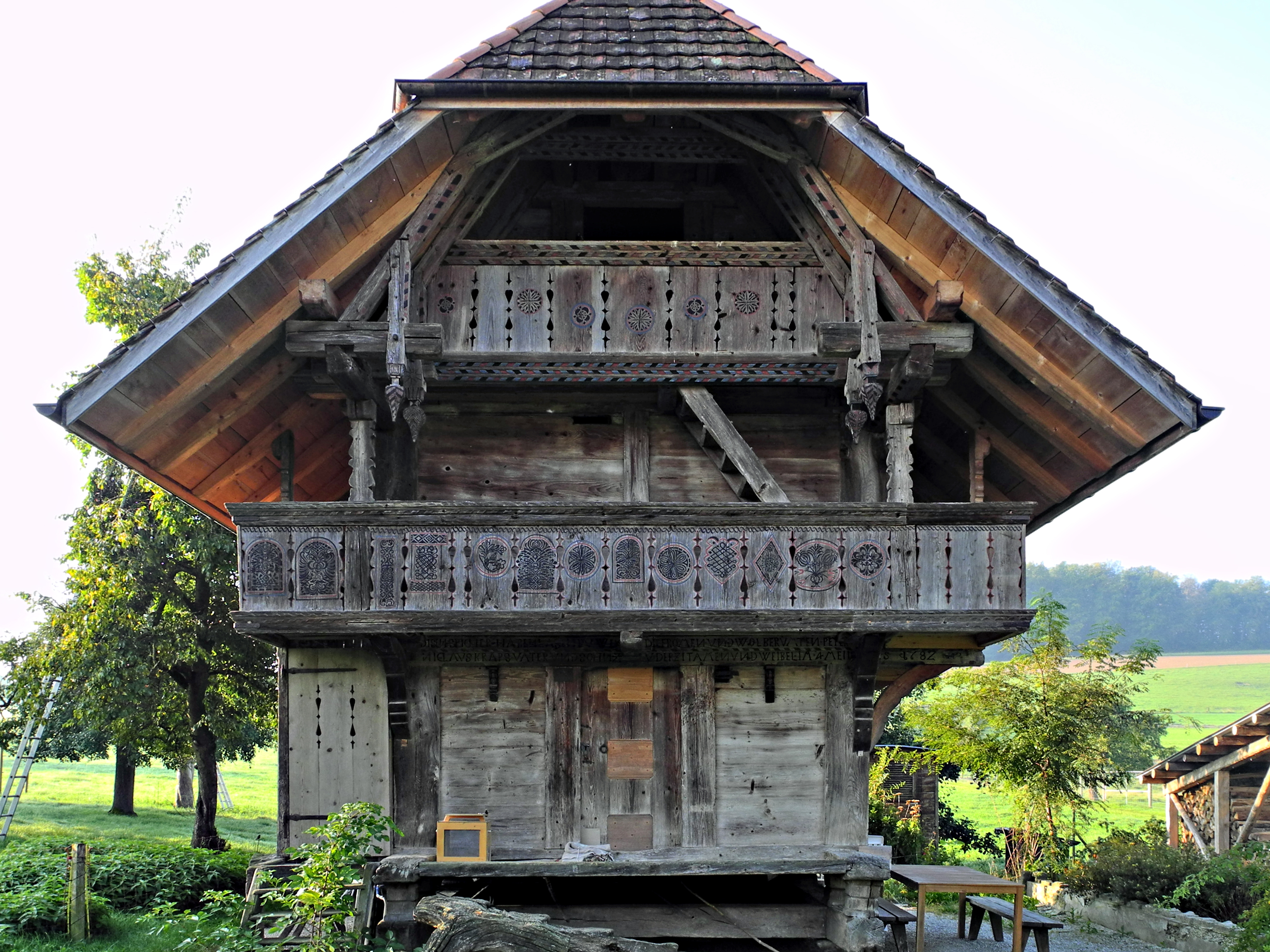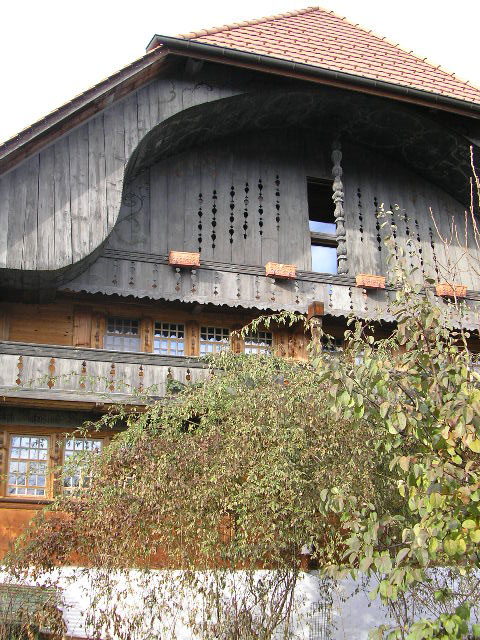|
Gelterfingen
Gelterfingen is a former municipality in the Bern-Mittelland administrative district in the canton of Bern in Switzerland. On 1 January 2018 the former municipalities of Gelterfingen, Mühledorf and Noflen merged into the municipality of Kirchdorf. History Gelterfingen is first mentioned in 1345 as ''Geltolfingen''. The oldest trace of a settlement in the area are several Hallstatt graves which were discovered at Hole. During the Middle Ages Gelterfingen was owned by the Freiherr von Kramburg. In 1373 it was acquired by the Knights Hospitaller at Münchenbuchsee Commandery. In 1528, Bern adopted the new faith of the Protestant Reformation, secularized the Commandery and acquired all its lands including Gelterfingen. Under Bernese control it was combined into a court with Kramburg and placed into the Seftigen district. The swampy valley floor of the Gürbetal forced the village farmers to raise their crops on the surrounding hills. The valley floor was only used as a pa ... [...More Info...] [...Related Items...] OR: [Wikipedia] [Google] [Baidu] |
Mühledorf, Bern
Mühledorf is a former municipality in the Bern-Mittelland administrative district in the canton of Bern in Switzerland. On 1 January 2018 the former municipalities of Gelterfingen, Mühledorf and Noflen merged into the municipality of Kirchdorf. History Mühledorf is first mentioned in 1364 as ''Mülidorf''. During the Middle Ages the village was part of the barony of Kramburg. In 1373 the village was donated to the Münchenbuchsee Commandery. In 1528, Bern accepted the new faith of the Protestant Reformation and suppressed the Commandery. Mühledorf came under Bernese rule and in 1533 was assigned to the court of Gelterfingen in the district of Seftigen created. The village has always been part of the parish of Kirchdorf. The Gürbe and Müsche river projects of 1855-1911 drained the swampy valley floor and opened up farmland. It also made it possible to build roads to Belp and Rümligen. Today, agriculture is still the main industry. However, around two-thirds of th ... [...More Info...] [...Related Items...] OR: [Wikipedia] [Google] [Baidu] |
Kirchdorf, Bern
Kirchdorf is a municipality in the Bern-Mittelland administrative district in the canton of Bern in Switzerland. On 1 January 2018 the former municipalities of Gelterfingen, Mühledorf and Noflen merged into the municipality of Kirchdorf. History Kirchdorf is first mentioned in 1228 as ''Chilthorf''. The oldest trace of a settlement in the area are several La Tène graves near the current cemetery. A prehistoric earthwork in the Gestelenwald may have had a village near it. During the Middle Ages a number of local nobles and patricians owned rights or land in the village. From the 13th until the 15th century several monasteries bought or received much of the village. In 1507-08 Jakob von Wattenwyl acquired all the scattered rights and land holdings and combined them into a single ''Herrschaft''. He than sold the territory and Kirchdorf passed through a number of owners. In 1645, the village council acquired the Kirchdorf court, which they then sold to Bern for 1,000 pound ... [...More Info...] [...Related Items...] OR: [Wikipedia] [Google] [Baidu] |
Gerzensee
Gerzensee is a municipality in the Bern-Mittelland administrative district in the canton of Bern in Switzerland. The town is named after its lake: Gerzensee. History Gerzensee is first mentioned in 1228 as ''Gercentse''. The oldest trace of a settlement in the area comes from scattered neolithic artifacts found around the municipality. La Tène and Roman era artifacts indicate that the area remained settled. By the Middle Ages the Freiherr von Kramburg had built his Festi Castle above the village and ruled over part of the valley. After about 1300 the Kramburg lands were acquired by another noble. Over the following centuries, the land was traded and sold multiple times. At the end of the 17th century Gerzensee was divided in half and each half was sold to a different noble family. The Festi Castle or Old Castle was damaged in a fire in 1518. Jakob von Wattenwyl had the old building rebuilt in a late-Gothic style under the direction of the master builder Balthasar Amb� ... [...More Info...] [...Related Items...] OR: [Wikipedia] [Google] [Baidu] |
Kaufdorf
Kaufdorf is a municipality in the Bern-Mittelland administrative district in the canton of Bern in Switzerland. History Kaufdorf is first mentioned in 1148 as ''Cuffedorf''. The village of Kaufdorf first appears in a record in 1319 when it was part of the '' Herrschaft'' of Burgistein. It was acquired by the vom Stein family and then in 1386 by the Spilmann family. They eventually donated the village to the Inselspital monastery in Bern. When Bern adopted the new faith of the Protestant Reformation in 1528, the monastery was secularized and the city acquired Kaufdorf. The village has always been part of the large parish of Thurnen. In 1495 the St. Ursus Chapel was built in the village. However it eventually was abandoned and is now in ruins. Between 1855 and 1911 a series of projects helped drain the marshy land along the Gürbe river and opened up new farm land. In 1901 the Gürbetal railroad (now part of the BLS) built a station in Kaufdorf. The railroad opened up the ... [...More Info...] [...Related Items...] OR: [Wikipedia] [Google] [Baidu] |
Noflen
Noflen is a former municipality in the Bern-Mittelland administrative district in the canton of Bern in Switzerland. On 1 January 2018 the former municipalities of Gelterfingen, Mühledorf and Noflen merged into the municipality of Kirchdorf. History Noflen is first mentioned in 1250 as ''Novelon''. Very little is known about the early history of the village. By the 13th and 14th centuries a number of monasteries and patrician families owned rights or land in Noflen. The monasteries probably expanded their power in the village over the following centuries. However, in 1528 Bern adopted the new faith of the Protestant Reformation and forcibly secularized monastery lands. Most likely this is when Noflen was acquired by Bern. The village has always been part of the parish of Kirchdorf. Today the residents of the village mostly raise dairy cattle and farm. Geography Noflen has an area of . As of 2012, a total of or 81.3% is used for agricultural purposes, while or 13.6% is ... [...More Info...] [...Related Items...] OR: [Wikipedia] [Google] [Baidu] |
Bern-Mittelland (administrative District)
Bern-Mittelland District in the Canton of Bern was created on 1 January 2010. It is part of the Bern-Mittelland administrative region, and is the only district in the region. It contains 75 municipalities with an area of and a population () of . It is made up of the valley of the rivers Aare and Emme, some of the foothills of the Bernese Alps, as well as the plain around the capital Bern, and has many small farms and hilly forested regions with small to mid-sized towns scattered throughout. It is perhaps best known by foreigners and visitors for the Emmental. The classic Swiss cheese with holes Emmentaler comes from this region's forests and pastures, of hilly and low mountainous countryside in the range. Municipalities Mergers and name changes *On 1 January 2011 the former municipalities of Albligen and Wahlern merged to form the new municipality of Schwarzenburg. [...More Info...] [...Related Items...] OR: [Wikipedia] [Google] [Baidu] |
Kirchenthurnen
Kirchenthurnen is a former municipality in the Bern-Mittelland administrative district in the canton of Bern in Switzerland. On 1 January 2020 the former municipalities of Kirchenthurnen, Lohnstorf and Mühlethurnen merged to form the municipality of Thurnen. History Kirchenthurnen is first mentioned in 1228 as ''Tornes''. Until 1860 it was known as ''Thurnen''. The name was changed to prevent confusion with the municipality of Mühlethurnen. The oldest trace of a settlement in the area are several Hallstatt era graves discovered at the Ried gravel pit. By the 14th century the village was owned by the von Blankenburg family from Bern The village church was first mentioned in 1228. In 1343 the village, church and surrounding lands were donated by the Blankenburgs to Interlaken Abbey. In 1528 Bern adopted the new faith of the Protestant Reformation and forcefully secularized Interlaken Abbey. This brought Kirchenthurnen under Bernese rule and it became the center of the bai ... [...More Info...] [...Related Items...] OR: [Wikipedia] [Google] [Baidu] |
Rümligen
Rümligen is a former municipality in the Bern-Mittelland administrative district in the canton of Bern in Switzerland. On 1 January 2021 the former municipality of Rümligen merged into Riggisberg. History Rümligen is first mentioned in 1075 as ''Rumelingen''. The oldest trace of a settlement in the area is a cache of Early-Bronze Age axes. During the High Middle Ages the Freiherr von Rümligen owned a vast swathe of land between the Gürbe and Sense rivers. They donated some of their estates to found and support Rüeggisberg and Röthenbach Priories. In 1380 the Sommerau-Rümligen family inherited the land when Alisa von Rümligen married into the Sommerau family. In 1388 the Freiherren came under Bernese control, though they continued to own the estates for another century and a half. In 1515 the Sommerau-Rümligen lost the ''Herrschaft'' and by the 17th century a series of Bernese patrician families owned Rümligen. In 1709 Samuel Frisching, built the modern Rümlig ... [...More Info...] [...Related Items...] OR: [Wikipedia] [Google] [Baidu] |
Toffen
Toffen is a municipality in the Bern-Mittelland administrative district in the canton of Bern in Switzerland. It lies approximately 10 km south of the city of Bern. The palace situated there, Toffen Castle, is a heritage site of national significance. History Toffen is first mentioned in 1148 as ''Toffen''. The oldest trace of a settlement in the area is a Bronze Age grave which was discovered near the castle. During the Roman era there was a manor house near Bodenacker. In addition to the house, Roman coins and ceramics have been found around the municipality. The Romans also quarried Tuff stone from the area and the Latin word for Tuff, ''tofus'' probably becoming Toffen. By the 13th century it was part of the '' Herrschaft'' of the Freiherr von Belp- Montenach. Around 1300 the village was acquired by another noble family and for several centuries it was owned by a number of different noble families. By the mid-14th century Bern ruled over the village and the ow ... [...More Info...] [...Related Items...] OR: [Wikipedia] [Google] [Baidu] |
Belpberg
Belpberg is a former municipality in the Bern-Mittelland administrative district in the canton of Bern in Switzerland. The municipality of Belpberg merged on 1 January 2012 into the municipality of Belp.Amtliches Gemeindeverzeichnis der Schweiz published by the Swiss Federal Statistical Office accessed 21 December 2011 The villages historic dependency on agriculture, and cattle breeding have continued to the present day. There is otherwise little employment within the commune, and most of the working inhabitants |
Hamlet (place)
A hamlet is a human settlement that is smaller than a town or village. Its size relative to a parish can depend on the administration and region. A hamlet may be considered to be a smaller settlement or subdivision or satellite entity to a larger settlement. The word and concept of a hamlet has roots in the Anglo-Norman settlement of England, where the old French ' came to apply to small human settlements. Etymology The word comes from Anglo-Norman ', corresponding to Old French ', the diminutive of Old French ' meaning a little village. This, in turn, is a diminutive of Old French ', possibly borrowed from ( West Germanic) Franconian languages. Compare with modern French ', Dutch ', Frisian ', German ', Old English ' and Modern English ''home''. By country Afghanistan In Afghanistan, the counterpart of the hamlet is the qala ( Dari: قلعه, Pashto: کلي) meaning "fort" or "hamlet". The Afghan ''qala'' is a fortified group of houses, generally with its ... [...More Info...] [...Related Items...] OR: [Wikipedia] [Google] [Baidu] |



_186.jpg)


